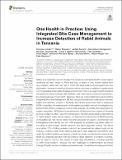One Health in Practice: Using Integrated Bite Case Management to Increase Detection of Rabid Animals in Tanzania.

View/
Date
2020-02-14Author
Lushasi, Kennedy
Steenson, Rachel
Bernard, Jubilate
Changalucha, Joel
Govella, Nicodem
Haydon, Daniel
Hoffu, Husna
Lankester, Felix
Magoti, Frank
Mtema, Zacharia
Nonga, Hesron
Hampson, Katie
Mpolya, Emmanuel
Metadata
Show full item recordAbstract
Rabies is a neglected zoonotic disease that causes an estimated 59,000 human deaths worldwide annually, mostly in Africa and Asia. A target of zero human deaths from dog-mediated rabies has been set for 2030, and large-scale control programs are now advocated. However, in most low-income endemic countries surveillance to guide rabies control is weak and few cases of rabies are recorded. There is an urgent need to enhance surveillance to improve timely case detection and inform rabies control and prevention, by operationalizing a "One Health" approach. Here we present data from a study piloting Integrated Bite Case Management (IBCM) to support intersectoral collaboration between health and veterinary workers in Tanzania. We trained government staff to implement IBCM, comprising risk assessments of bite patients by health workers, investigations by livestock field officers to diagnose rabid animals, and use of a mobile phone application to support integration. IBCM was introduced across 20 districts in four regions of Tanzania and results reported after 1 year of implementation. Numbers of bite patient presentations to health facilities varied across regions, but following the introduction of IBCM reporting of bite patients at high-risk for rabies more than doubled in all regions. Over 800 high-risk investigations were carried out, with 49% assessed as probable dog rabies cases on the basis of clinical signs, animal outcome, and rapid diagnostic testing. The status of a further 20% of biting animals could not be determined but rabies could not be ruled out. Livestock field officers reported that use of rapid diagnostic tests (RDTs) were useful for confirming rabies occurrence. Overall, our study provides further evidence that IBCM is a practical approach that can improve rabies detection in endemic countries, and be used to monitor the impact of mass dog vaccinations, including potential to verify rabies freedom. However, the main challenges to implementation are limited training of health workers in rabies, perceived burden of real-time recording and limited resources for livestock field officers to undertake investigations. Nonetheless, IBCM dramatically improved case detection and communication between sectors and we recommend further implementation research to establish best practice and applicability to other settings.
